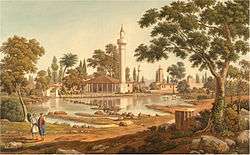Pherae

Pherae is the English transliteration of two towns in Ancient Greece.
In Thessaly
Pherae (Greek: Φεραί) was a city in southeastern Thessaly.[1] One of the oldest Thessalian cities it was located in the southeast corner of Pelasgiotis.[2] According to Strabo, it was near Lake Boebeïs 90 stadia from Pagasae, its harbor on the Gulf of Pagasae (Geography 9.5).
In Homer Pherae was the home of King Admetus and his wife, Alcestis, (whom Heracles went into Hades to rescue), as well as their son Eumelus (who was one of the suitors of Helen and led the Achaean forces of Pherae and Iolcus in the Trojan War) (Iliad 2.711; Odyssey 4.798).
Thucydides lists Pherae among the early Thessalian supporters of Athens at the beginning of the Peloponnesian War (History of the Peloponnesian War 2.22). Toward the end of the war Lycophron established a tyranny at Pherae. On his death his son Jason became dictator and by around 374 B.C.E. extended his rule throughout Thessaly. After Jason's assassination and that of his two successors Alexander ruled Phere with great harshness until he was killed by his wife Thebe in 359 B.C.E., and Thessaly was conquered by the Thebans. Philip of Macedon conquered Pherae in 352 B.C.E. and subjected Thessaly to Macedonian rule.
In Roman times Pherae was conquered by Antiochus the Great of Syria in 191 B.C.E., but lost it that same year to Roman consul Acilius (Livy 36.1-14). The famous Messeis spring (the spring of Kefalovryso at Velestino) was probably at Pherae (Strabo, Geography 9.5; Iliad 6.457).
In Messenia
The second town, sometimes transliterated "Pharae" (Greek: Φηραί), was located in Messenia.[3] Strabo locates the town on the bank of the Nedon river, five stadia from the sea (the Messenian Gulf) (Geography 8.4. 8.5); Pausanias says six stadia (Description of Greece 4.31.1). Smith attributes the discrepancy to the accumulation of silt over time at the mouth.[4]
Pausanias wrote that Pherae had been founded by Pharis, son of Hermes and the Danaid Phylodameia (Description of Greece 4.30.2; 7.22.3). Pausanias distinguishes this city from the Achaean city of Pharae (Φαραὶ), 150 stadia from Patrae and 70 stadia from the coast (Description of Greece 7.22.1), which Pausanias was unable to discover, whether the same town Pharis had founded or another by the same name (Description of Greece 7.22.5). The Messenian town was located on the site of modern Kalamata and, like the current Messenian capital, it probably also was the chief town of the southern Peloponnesian plain.[4]
In Homer, Pherae was the home of Diocles, whose sons Crethon and Orsilochus were killed by Aeneas (Iliad, 5. 541-550). As part of his entreaty to Achilles Agamemnon promised to include "holy Pherae" as one of seven "strongholds" in the dowry of the daughter Achilles chooses to marry if he returned to the fight on behalf of the Achaeans (Iliad 9.151). Strabo argues that Pherae must have belonged to the Atreides; otherwise Agamemnon would not have offered it. The home of Diocles is also where Telemachus and Peisistratus spent a night at his house on their way from Pylos to visit king Menelaus in Lacedaemon (Odyssey 3.488-90) and their return (Odyssey 16.186).
Xenophon records that Pherae (Φεραί) was one of the Lacedaemonian cities razed by Persian satrap Pharnabazus II and Athenian General Conon during the Corinthian War (in 394 B.C.E.) (Hellenica 4.8.7).
Pausanias says that because Messenia sided with Antony during the Roman civil war (Description of Greece 4.31.1), Augustus punitively had Pherae and all of Messenia incorporated into Laconia (Description of Greece 4.30.2). When Pausanias visited it, Pherae had a temple dedicated to Fortune (Tyche) (Description of Greece 4.30.2).
See also
- Modern Feres, Magnesia (1)
- Modern Kalamata (2)
References
- ↑ Autenrieth, Georg (1891). "Φεραί". A Homeric Dictionary for Schools and Colleges. New York: Harper and Brothers.
- ↑ Smith, William (1854). "Pherae (Φέραι) (1)". Dictionary of Greek and Roman Geography. London: Walton and Maber.
- ↑ Autenrieth, Georg (1891). "Φηραί, Φηρή". A Homeric Dictionary for Schools and Colleges. New York: Harper and Brothers.
- 1 2 Smith, William (1854). "Pharae (Φαραί) (2)". Dictionary of Greek and Roman Geography. London: Walton and Maber.
Coordinates: 39°23′01″N 22°44′47″E / 39.3836111111°N 22.7463888889°E